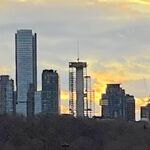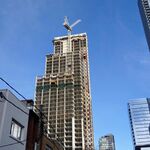A
AlvinofDiaspar
Guest
From the Star:
North York needs an ardent crusader
January 22, 2007
Royson James
With so much email reaction to the column on North York's "downtown" – more appropriately tagged condotown – an appropriate question is: Who is responsible for fixing this. Can the Yonge Street corridor stretching from the 401 to Finch be remediated, improved, tamed into a more friendly, human scale?
For that to happen, someone should be thinking about the possibilities – and there is little evidence of this occurring.
When was the last time you heard city councillors who hail from North York have a debate on creating a sense of place out of Toronto's largest and most commercially successful sub-centre? On the contrary, the area – despite its enormous natural, geographic and infrastructure blessings – suffers from a lack of care and love. Its failure lies in a polarization of extreme philosophies.
Former Mayor Mel Lastman did what he did best – build big and bold, without attention to detail and form and scale. In many ways, his frontier spirit was needed to create what the Metro Toronto planners had envisioned: a series of viable commercial hubs outside downtown Toronto.
What has been missing is a forceful personality or group or movement to take this skeleton and grow people-oriented flesh and sinews and organs that make it livable. Response to Mel's "big, brash and bold" too often is status quo and "do little." Consequently, we have what he built, and nothing more.
"Who is responsible for the future planning of the Sheppard-Yonge area, which today is certainly not a neighbourhood or community?" asks reader Phyllis Broder, who says she's recently moved into the condo canyon.
When Mel ruled over North York, the central Willowdale ratepayers fought to preserve the single-family neighbourhoods on either side of Yonge. During the 1980s, Mel allowed them to write the rules that would govern the Yonge development. Naturally, they focused on their own interests, with good results. The skyscrapers have created a vertical downtown with which the abutting single-family homes co-exist nicely. Property values have skyrocketed.
But where are the amenities along the strip? There has not been a consistent advocate for the Street, Yonge St., the city's most important road.
There are many good elements to work with.
High-rise living isn't the scourge some make it to be. The condos themselves are appropriately placed – with two subway lines and Highway 401 defining the area. And when the Ford Centre for the Performing Arts was in its heyday, Garth Drabinsky at the helm, there was a bit of a night life and a few good restaurants. The condo-retail development across from Mel Lastman Square is well conceived. The open air supermarket a surprisingly attractive experience.
Linda Rogers writes to remind us there is a professional orchestra playing out of the George Weston recital hall, renowned for its acoustics. The orchestra's North York name has been changed and it might be perceived as "just another Toronto" orchestra, but it has a 35-year history in North York.
"On Feb. 8, we are presenting the North American debut of a stunning young Korean violinist, Jung Yoon Yang," Rogers says.
Resident in the same hall, the Nathaniel Dett Chorale, which performs exquisite Afro-centric choral music, is gaining international acclaim.
A few blocks south of the performing arts centre is the new Claude Watson School for the Arts, a spectacular addition. The only negative, I see, in this new building for talented students of the arts, is it would be so much more appreciated if it fronted on Yonge, instead of toward Doris Ave., east of Yonge.
But there's not enough green space. The Yonge median was supposed to be an attractive, University Avenue-like experience but the summer plantings are less than spectacular. Why? A drive or walk along upper Yonge, through Richmond Hill, is a much more delightful experience.
"There is no concern about the people who LIVE here or work in the area or use the subway to get to and from work and home," Broder complains.
North York has enough smart and energetic councillors to put their minds to civic centre renewal. Howard Moscoe has spent much time on transit and taxi industry. John Filion, who represents the area, has argued for more people-oriented development but spends his efforts on the board of health. Shelley Carroll is budget chief.
Scarborough councillors seem to have an affinity to their underdog area of the city. Do North York councillors?
Unfortunately, they have washed their hands of their civic centre. It's almost as if they have chosen to ignore and abandon the centre because their adversary Mel Lastman was responsible for building it in the first place.
The condo residents are not fussed by who made the mistakes. They want fixes – ones that are eminently doable – that will make their home a place to live, not just a commercial destination.
Two of three people who work in North York's downtown but live elsewhere told a 2005 survey that they do so because they like their neighbourhood better.
So, if planners want more people living and working in the North York Centre area, they must build condos, yes; build offices, yes; but they must create a beautiful and desirable community to house the workers and residents.
To rezone the key lots earmarked for office towers and convert the use to condos is foolish and short-sighted. To add concrete upon concrete without creating some on-the-ground places of rest and refuge and beauty and contemplation and human interaction and connection is to abandon any hope of creating a neighbourhood, a place for people.
AoD
North York needs an ardent crusader
January 22, 2007
Royson James
With so much email reaction to the column on North York's "downtown" – more appropriately tagged condotown – an appropriate question is: Who is responsible for fixing this. Can the Yonge Street corridor stretching from the 401 to Finch be remediated, improved, tamed into a more friendly, human scale?
For that to happen, someone should be thinking about the possibilities – and there is little evidence of this occurring.
When was the last time you heard city councillors who hail from North York have a debate on creating a sense of place out of Toronto's largest and most commercially successful sub-centre? On the contrary, the area – despite its enormous natural, geographic and infrastructure blessings – suffers from a lack of care and love. Its failure lies in a polarization of extreme philosophies.
Former Mayor Mel Lastman did what he did best – build big and bold, without attention to detail and form and scale. In many ways, his frontier spirit was needed to create what the Metro Toronto planners had envisioned: a series of viable commercial hubs outside downtown Toronto.
What has been missing is a forceful personality or group or movement to take this skeleton and grow people-oriented flesh and sinews and organs that make it livable. Response to Mel's "big, brash and bold" too often is status quo and "do little." Consequently, we have what he built, and nothing more.
"Who is responsible for the future planning of the Sheppard-Yonge area, which today is certainly not a neighbourhood or community?" asks reader Phyllis Broder, who says she's recently moved into the condo canyon.
When Mel ruled over North York, the central Willowdale ratepayers fought to preserve the single-family neighbourhoods on either side of Yonge. During the 1980s, Mel allowed them to write the rules that would govern the Yonge development. Naturally, they focused on their own interests, with good results. The skyscrapers have created a vertical downtown with which the abutting single-family homes co-exist nicely. Property values have skyrocketed.
But where are the amenities along the strip? There has not been a consistent advocate for the Street, Yonge St., the city's most important road.
There are many good elements to work with.
High-rise living isn't the scourge some make it to be. The condos themselves are appropriately placed – with two subway lines and Highway 401 defining the area. And when the Ford Centre for the Performing Arts was in its heyday, Garth Drabinsky at the helm, there was a bit of a night life and a few good restaurants. The condo-retail development across from Mel Lastman Square is well conceived. The open air supermarket a surprisingly attractive experience.
Linda Rogers writes to remind us there is a professional orchestra playing out of the George Weston recital hall, renowned for its acoustics. The orchestra's North York name has been changed and it might be perceived as "just another Toronto" orchestra, but it has a 35-year history in North York.
"On Feb. 8, we are presenting the North American debut of a stunning young Korean violinist, Jung Yoon Yang," Rogers says.
Resident in the same hall, the Nathaniel Dett Chorale, which performs exquisite Afro-centric choral music, is gaining international acclaim.
A few blocks south of the performing arts centre is the new Claude Watson School for the Arts, a spectacular addition. The only negative, I see, in this new building for talented students of the arts, is it would be so much more appreciated if it fronted on Yonge, instead of toward Doris Ave., east of Yonge.
But there's not enough green space. The Yonge median was supposed to be an attractive, University Avenue-like experience but the summer plantings are less than spectacular. Why? A drive or walk along upper Yonge, through Richmond Hill, is a much more delightful experience.
"There is no concern about the people who LIVE here or work in the area or use the subway to get to and from work and home," Broder complains.
North York has enough smart and energetic councillors to put their minds to civic centre renewal. Howard Moscoe has spent much time on transit and taxi industry. John Filion, who represents the area, has argued for more people-oriented development but spends his efforts on the board of health. Shelley Carroll is budget chief.
Scarborough councillors seem to have an affinity to their underdog area of the city. Do North York councillors?
Unfortunately, they have washed their hands of their civic centre. It's almost as if they have chosen to ignore and abandon the centre because their adversary Mel Lastman was responsible for building it in the first place.
The condo residents are not fussed by who made the mistakes. They want fixes – ones that are eminently doable – that will make their home a place to live, not just a commercial destination.
Two of three people who work in North York's downtown but live elsewhere told a 2005 survey that they do so because they like their neighbourhood better.
So, if planners want more people living and working in the North York Centre area, they must build condos, yes; build offices, yes; but they must create a beautiful and desirable community to house the workers and residents.
To rezone the key lots earmarked for office towers and convert the use to condos is foolish and short-sighted. To add concrete upon concrete without creating some on-the-ground places of rest and refuge and beauty and contemplation and human interaction and connection is to abandon any hope of creating a neighbourhood, a place for people.
AoD




